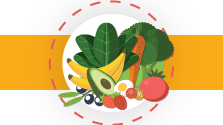Key points
- Eating enough fruits and vegetables each day is an important way for people to improve their health.
- To improve consumption of fruits and vegetables, states and local communities can implement new fruit and vegetable voucher incentive and produce prescription programs—or can refine and expand existing programs.

Background

Good nutrition is essential in keeping current and future generations of Americans healthy across the lifespan. Children need fruits and vegetables daily for healthy growth and brain development. People with healthy eating patterns live longer and are at lower risk for serious health problems such as heart disease, type 2 diabetes, and obesity.
Only 1 in 10 US adults eats enough fruits and vegetables every day. Many groups have limited access to affordable, healthy foods such as fruits and vegetables. These groups include people living in rural areas, tribal communities, and neighborhoods where most residents have lower incomes. People with disabilities may also be affected. In addition, people in some racial and ethnic groups may not have access to culturally preferred, healthy foods.
Two key, evidence-based public health strategies that improve consumption of fruits and vegetables are fruit and vegetable incentives and produce prescription programs. They are often coupled with education programs on food, cooking, and nutrition necessary for a healthy diet. These programs also increase market demand for fruits and vegetables, which can increase sales for local farmers, food hubs, aggregators, distributors, and retailers.
Did you know?
Fruit and vegetable incentives are coupons or cash incentives that consumers can use at the point of purchase.
Produce prescriptions are prescriptions for fruits and vegetables to be used in a health care setting or in the patient's community.
Some states and communities have existing fruit and vegetable incentive and produce prescription programs that could be expanded. Some insurance payers or health systems may offer programs that states and communities could adapt and expand. A variety of partners—including growers, food retailers, and community members—typically needs to be involved in program development, communication, coordination, implementation, and evaluation. Planning and operating these programs require working across sectors, including health care, transportation, and agriculture. Include sectors that can ensure a sufficient supply of culturally preferred fruits and vegetables.
Potential state activities
Tip
On this page:
* Indicates short-term activities that may be accomplished in 1 to 2 years.
+ Indicates activities that may take up to 5 years, depending on the organization's capacity, previous work in this area, and size of the project.
- Engage representatives from Medicaid programs (including state agencies, payers, and health systems) in implementation, expansion, and evaluation of fruit and vegetable incentive or produce prescription programs.+
- Support policies that increase participation in incentive or prescription initiatives, such as state benefit coverage for patients enrolled in these programs or state waivers that provide resources or funding for these programs.+
- Convene state agencies to align activities related to incentive or prescription programs. Integrate these activities into new or existing state food plans or charters.* Relevant state agencies include those involved in:
- Food system
- Feeding programs
- Disaster response
- Environmental sustainability
- Health care
- Aging services
- Nutrition security
- Food system
- Support the expansion of technologies that allow food businesses to accept program vouchers as payment. Examples are statewide payment systems or online grocery platforms.+
- Share resources, such as data or staffing, that support incentive or prescription programs.*
- Train state partners to operate incentive and prescription programs.*
Potential state and local activities
- Coordinate partnerships across organizations to make it easier to apply for funding and get access to:
- Resources and data.
- Program infrastructure and staffing.
- Program enrollment support.
- Evaluation support.*
- Resources and data.
- Strengthen or launch regional, state, or local food policy councils of diverse, cross-sector food system partners. These groups may represent:
- Feeding programs.
- Disaster response.
- Environmental sustainability.
- Food security.
- Health care.
- Food producers, distributors and retailers.
- Community members, including people who have lacked access to affordable, healthy foods.+
- Feeding programs.
- Train staff and all partners on food system best practices to reduce health disparities. Include approaches that are trauma-informed.+
- Create or expand a communication campaign(s) for priority communities to promote awareness and use of fruit and vegetable incentives and produce prescription programs. Use the campaign to improve the understanding of the importance of nutrition to health. Be sure the materials are culturally and linguistically appropriate for the priority groups.+
- Engage community members, food systems representatives, and other experts to ensure initiatives promote equity in the food system. For example, people who have lacked access to fruits and vegetables should help guide program development, implementation, and evaluation.
- Connect incentive and prescription programs to local food sources, including farmers and food business owners from socially disadvantaged groups. Also find out if redemption sites are offering culturally preferred foods. Help partners identify priority populations and learn how to tailor their nutrition education and marketing to these populations. Data sources for information include the Child Opportunity Index and Social Vulnerability Index.*
- Engage state and local transit authorities and planners to decrease barriers in taking public transit to sites that offer incentives or prescription redemption.+

Potential local activities
- Help local program providers identify funding sources for developing and implementing pilot programs. These may include buying produce, funding the incentive, or supporting nutrition education.*
- Help partners conduct community needs assessments to help develop or expand fruit and vegetable incentive or produce prescription programs.*
- Connect incentive and prescription programs to local food sources, including farmers and food business owners who are members of communities being served.+
- Support the use of technologies that allow food businesses to accept incentive vouchers as payment. For example, train partners to use these systems or support diverse food businesses to participate in these systems.+
- Support local policies that increase participation in incentive or prescription initiatives. Such policies could provide funding that makes it easier for food retailers that accept these incentives or prescriptions to sell produce.
- Create on-site food pantries at hospitals and clinics where space and staffing exist. Expand referral of patients and staff to these resources.*
- Support local farmers, food distributors, and business owners to help them grow, distribute, and sell fruits and vegetables needed for voucher incentive or produce prescription programs. Include members of the communities being served.+
- Strengthen links between regional food hubs or collective buying approaches to provide sources of culturally preferred foods for fruit and vegetable incentive and produce prescription programs.+
- Train local partners to implement fruit and vegetable incentive and produce prescription programs.*
- Build clinical-community linkages to learn what assets are already available, use screening and referral platforms, and engage community health workers.+

Working together
Washington's FV Incentive Program
Benefits people who are food insecure, the agricultural industry, and retailers across the state.
Fresh Bucks Produce Prescription Program in Marion County, Indiana
Fosters healthier eating habits to prevent and manage chronic diseases while improving nutrition insecurity.
New Mexico Fresh Rx
Produce prescription program provides incentives for patients to complement their current medical care by purchasing nutritious, New Mexico-grown produce.
Navajo FVRx
Produce prescription program allows families to buy fruits and vegetables at local stores on Navajo Nation with vouchers from clinic providers and community health workers. Participating stores are encouraged to offer a variety of fruits and vegetables, including locally grown produce from Navajo farmers.
Resources
Supporting Food and Nutrition Security Through Healthcare
Focuses on approaches that help the health care system provide nutritious food, or resources to access nutritious food, to patients with high risks of food insecurity.
Nutrition Incentive Hub
Resources to support nutrition incentive and produce prescription projects. Topics include reporting and evaluation; diversity, equity and inclusion; and marketing and communications.
Nutrition Guidelines for the Charitable Food System
Standards for use in food banks or pantries.
Food system coalitions
Structuring Your Food Policy Council
Blog post explores best practices for structuring food policy councils.
Get It Toolgether: Assessing Your Food Council's Ability to Do Policy Work
Toolkit for any food system group that works (or aspires to work) on policy, with self-assessment checklists in six areas.
Food Policy Council Self-Assessment Tool
Helps assess food policy members' perceptions of their council's organizational capacity, social capital, and council effectiveness.
Review of State Food Plans and Charters
Overview of US trends and a directory of state and regional food systems plans and charters.
Health Equity
An Introduction to Incorporating Diversity, Equity, and Inclusion (DEI) Into Nutrition Incentive Program Research and Evaluation
Details how to use a DEI lens when researching and evaluating nutrition incentive programs. Includes examples and questions for consideration.
Delivering More Than Food: Understanding and Operationalizing Racial Equity in Food Hubs
Presents themes, findings, and key takeaways for food hubs engaging in racial equity work.
Food Sovereignty Assessments: A Tool to Grow Healthy Native Communities
Background on food sovereignty assessments and findings from several assessments completed in native communities with funding from the First Nations Development Institute.
Cross-cutting areas
Communication tips for using communication to support program efforts.
Evaluation framework for making evaluations useful, feasible, ethical, accurate, and culturally responsive.
Health Equity tools to help remove barriers to health.
Definitions
Community-clinical linkages are connections between community and clinical sectors that aim to improve health in a community. They are an effective, evidence-based approach to preventing and managing chronic diseases and advancing health equity.
Culturally preferred foods are safe and nutritious foods that meet the diverse tastes and needs of customers based on their cultural identity.
Food system includes all processes needed to provide food—from the farm, ranch, or fishery—to the plate. The food system includes growers, distributors, and food retail business owners and can also include groups working in equitable food access through hunger relief, institutional and school foods, and other community programs.
Fruit and vegetable voucher incentive programs provide coupons or cash incentives to consumers to use at the point of purchase. Incentives may be redeemed at food pantries, farmers' markets, brick-and-mortar retail or online grocery stores, and mobile markets. Vouchers may also be used in community-supported agriculture, which is when people buy a subscription or "share" of a farm's produce so that growers and consumers share the risks and benefits of food production.
Produce prescription programs are a way for health care workers to prescribe fruits and vegetables, usually with vouchers to buy them, for patients with chronic diseases and lack of access to nutritious foods. The prescriptions may be used in the health care setting or local farmers' markets, brick-and-mortar or online grocery stores, or mobile markets. Many programs also offer nutrition education opportunities.
Sectors are groups with different areas of focus. Examples of sectors involved in fruit and vegetable voucher incentives and produce prescriptions are agriculture, health care, education, transit, social services, disaster response, feeding and food security, environmental sustainability, aging services, and mental and behavioral health.
State food charters highlight what state, county, city, and town governments can do to stimulate access to healthy foods for all. A charter recommends how decision-makers at all levels of government can distribute their efforts.
Trauma-informed practice/care is a model used in health and social service settings to address consequences of trauma, facilitate healing, and prevent re-traumatization. Trauma can include chronic or acute food insecurity.
Additional priority strategies:
Breastfeeding Continuity of Care
Increasing Physical Activity Through Community Design
Early Care and Education (ECE) Policies and Activities
